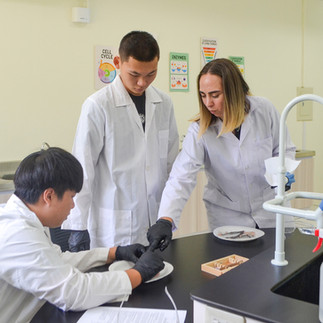From Classroom to Lab: Sport, Exercise, and Health Science in Action!
- Kelly Ho
- Oct 1
- 1 min read
Our Sport, Exercise, and Health Science class had the exciting opportunity to dissect chicken wings after completing units on the skeletal and muscular systems. This hands-on lab allowed students to see how bones, muscles, tendons, and ligaments work together to create movement. By observing the structures closely, they connected classroom learning with real anatomy, gaining a deeper understanding of how the human body functions. Experiences like this truly bring science to life and make learning unforgettable!
我們的學生們在運動、訓練與健康科學,上完骨骼與肌肉系統單元程後,進行了一場雞翅解剖實驗 。透過這次動手操作,學生能親眼觀察骨骼、肌肉、肌腱與韌帶如何協同作用,產生身體的動作。藉由實際觀察,他們將課堂所學與真實的解剖結構連結起來,進一步加深了對人體運作的理解 。像這樣的實作體驗,不僅讓科學「活起來」,更讓學習變得難以忘懷!















What a great way to turn textbook knowledge into real-world experience, Chill Guy Clicker, and help students gain a deeper understanding of anatomy!
Every time I see a Secret Gardens project, I’m reminded how powerful landscape Sydney can be in transforming the way we live outdoors.
If you are in search of an escort service you can trust in Escorts in Vasant Kunj, then consider this place to make introductions to hot women who are perfectly prepared to meet anytime and anywhere you please. Each and every escort guarantees to bring to you comfort, privacy, and sheer delight no matter it is a romantic dinner or private pleasure.
Are you looking for pure pleasure near you? Our Call Girls Service in Noida are willing to have romantic, playful fun at your doorstep. These lovely ladies who are 24x7 available, start at just ₹2999/hour with 20% Off for an advance booking. We let the night become one of your unforgettable fantasies by picking the girl you want.
It’s wonderful to see theory brought into practice in such an engaging way. I think dissecting chicken wings not only helps students better understand anatomical structures but also teaches them to observe carefully and draw conclusions from small details. For students, this topic requires Friday Night Funkin skills, as it demands a rhythmic coordination between theoretical knowledge and hands-on practice, much like blending different melodies into a vibrant piece of music. The question is: if students were given more diverse lab experiences, would they develop a more flexible mindset in connecting science with everyday life?